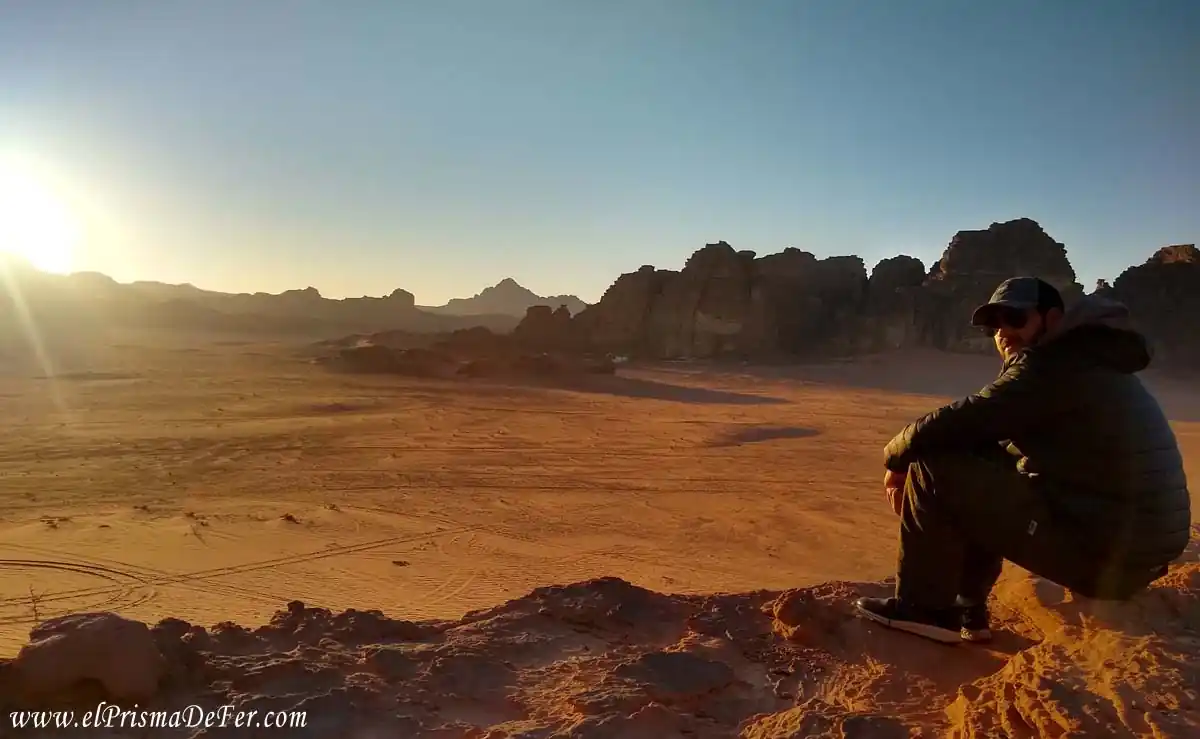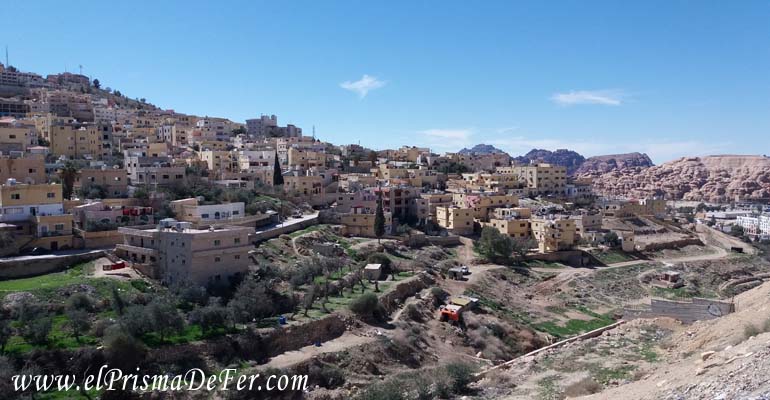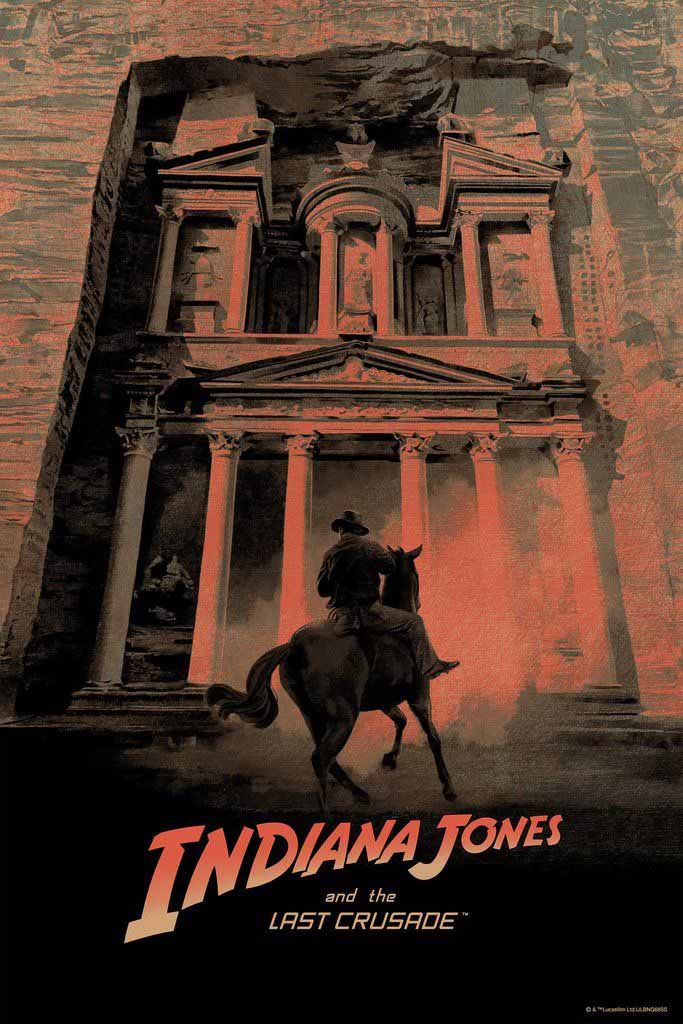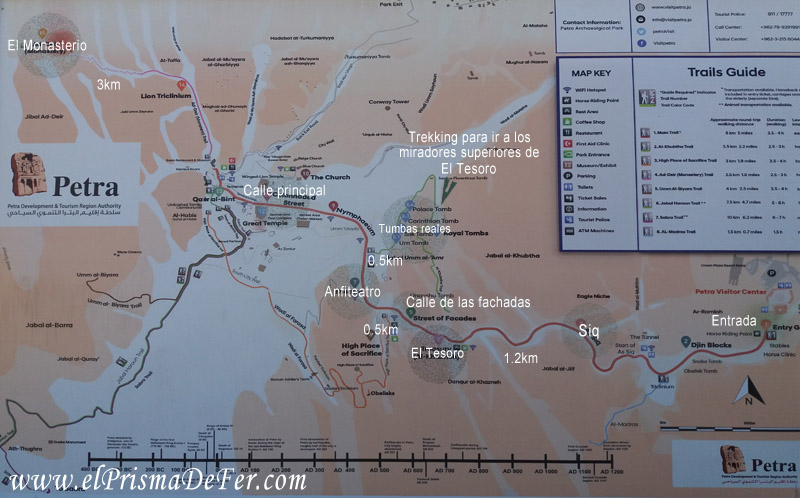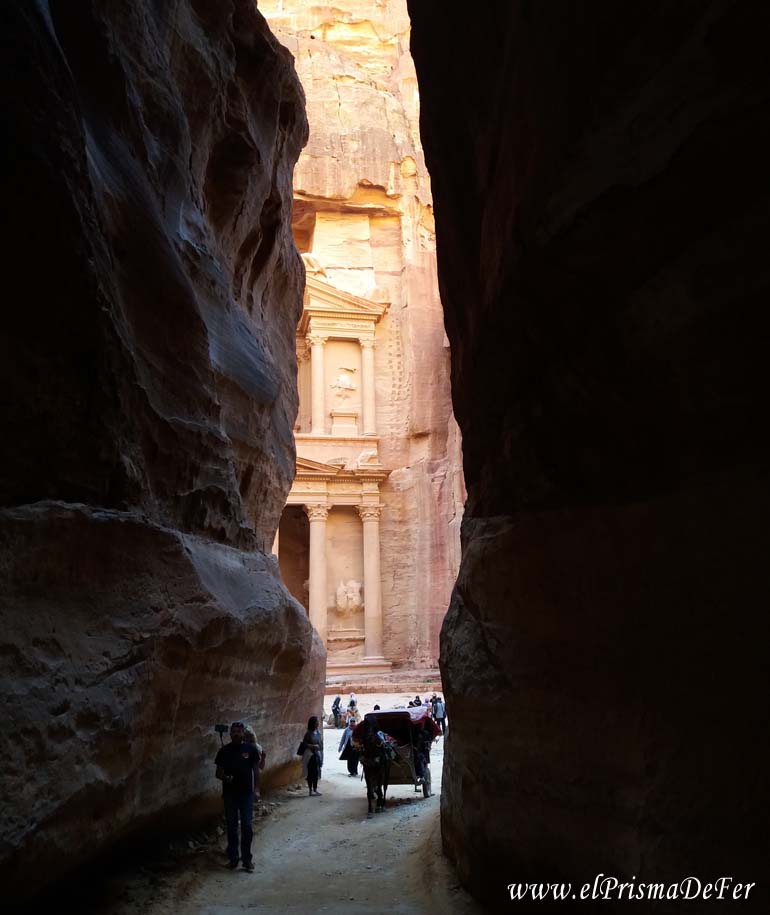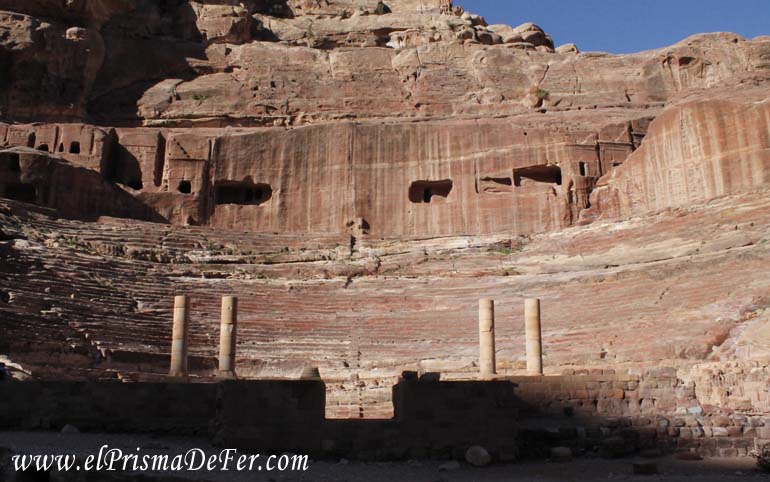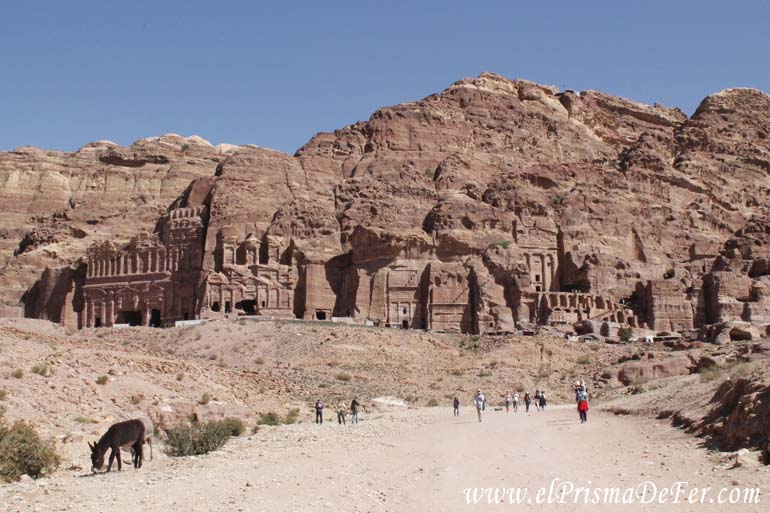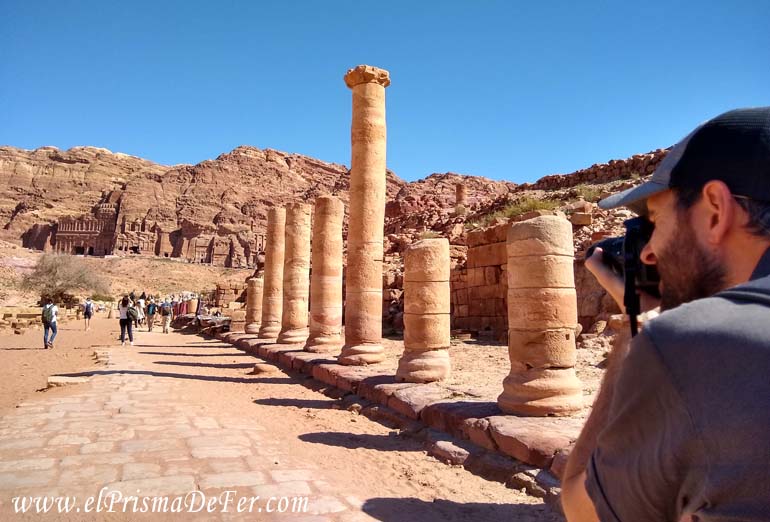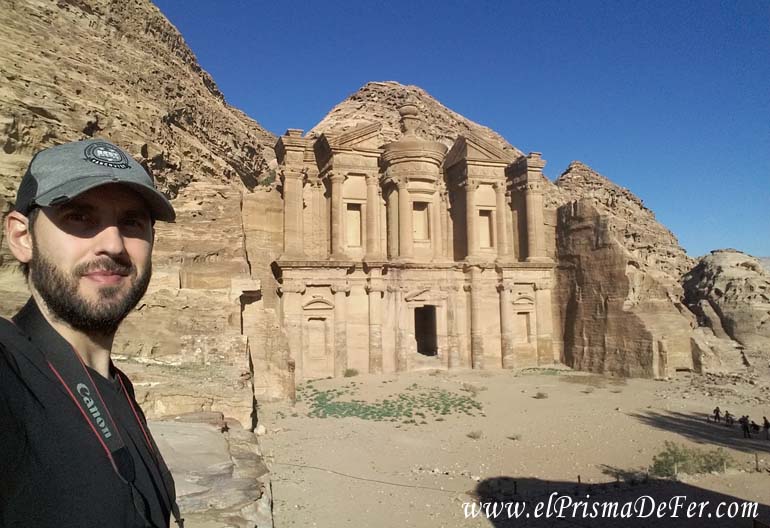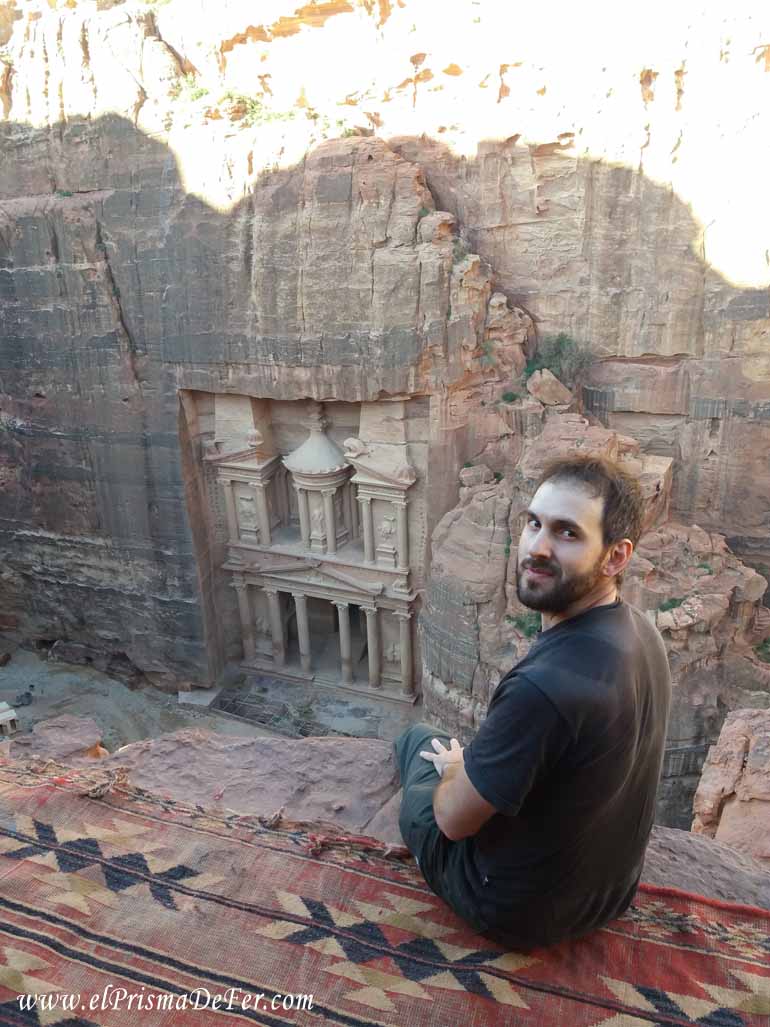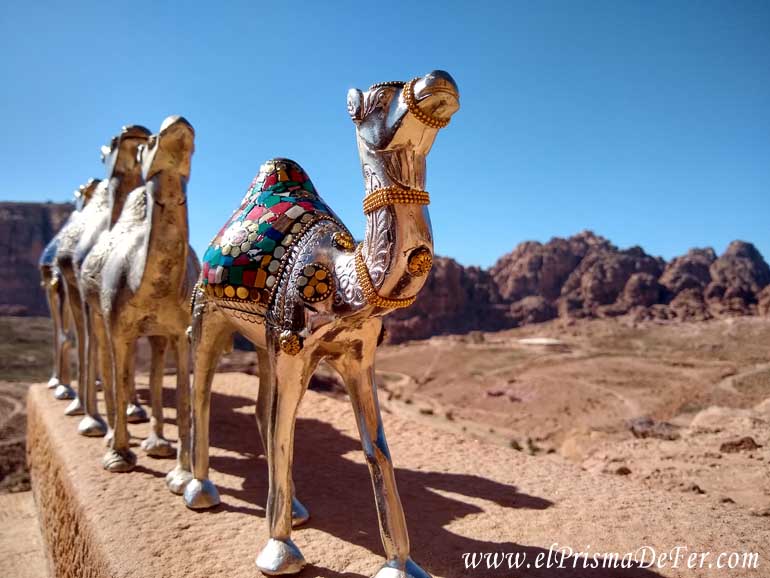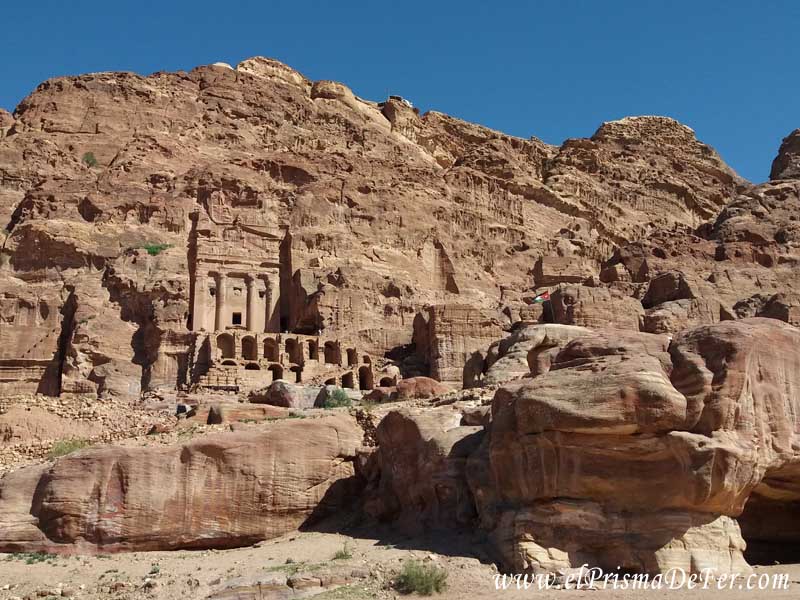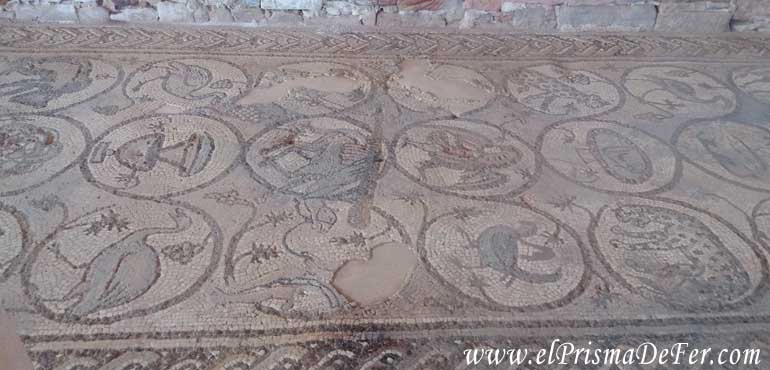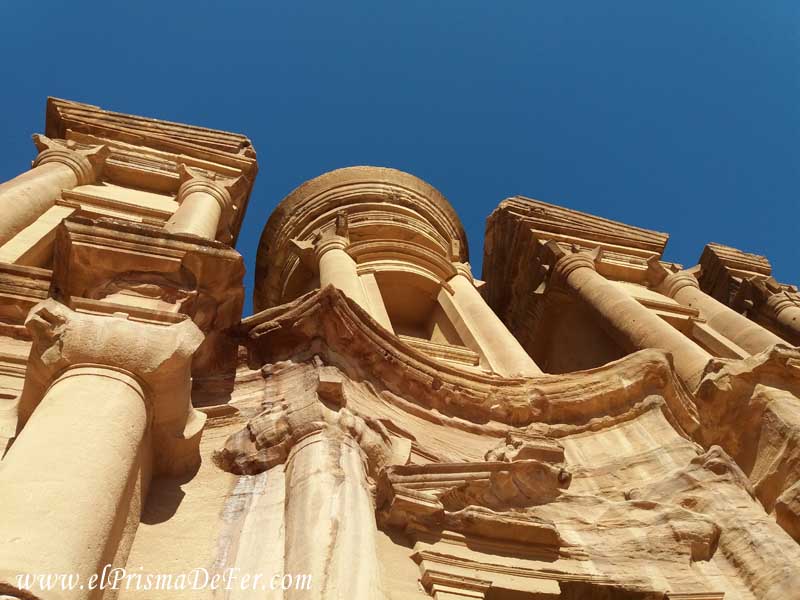Petra, the jewel of Jordan and one of the New Seven Wonders of the World, is a dream destination for travelers from all over the world. This archaeological site, built by the Nabataeans more than 2,000 years ago, is more than just the famous facade of the tomb known as The Treasury (the image that appears in every publication). Here you'll also find temples, tombs, and monumental structures carved into the pink desert rock. In this guide, I'll tell you what to see in Petra, with details on the main attractions, distances between each one, and practical tips to make the most of your visit.
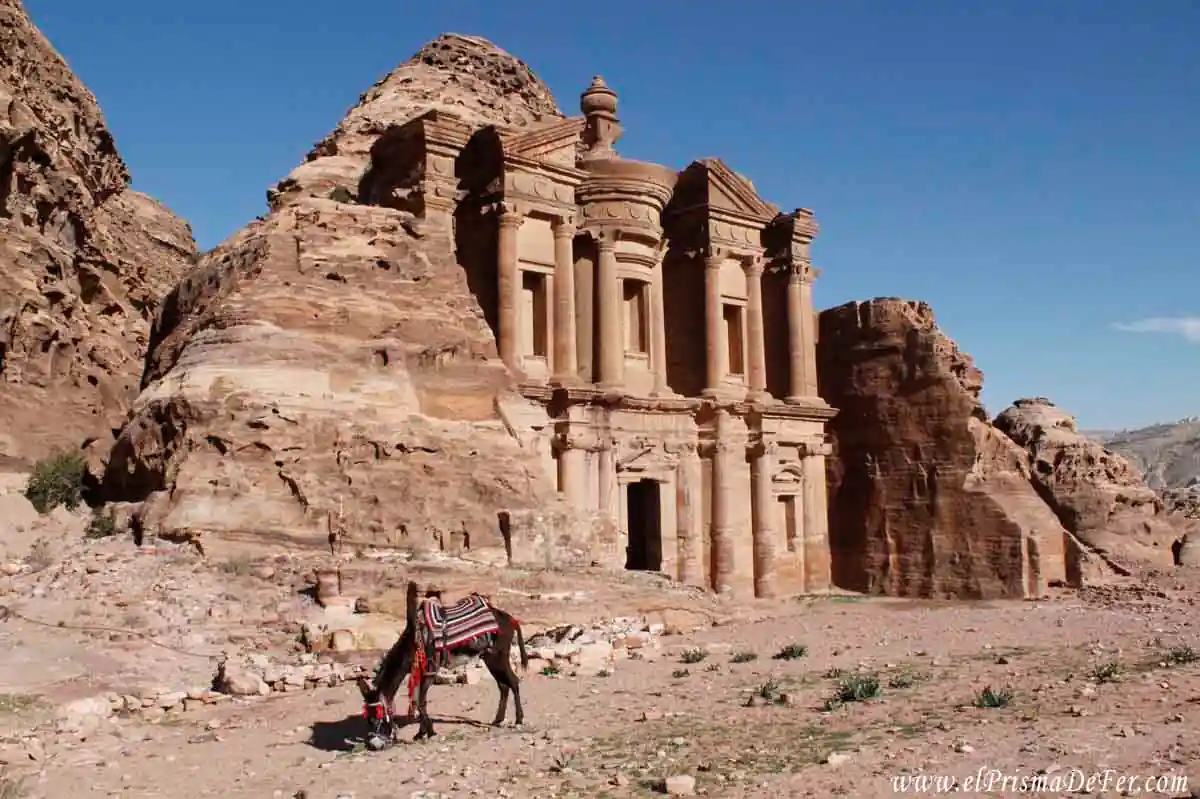
Table of Contents
Arriving at Wadi Musa, the base city for visiting Petra
We arrived at Wadi Musa from the Wadi Rum Desert. Every morning, a shuttle leaves from the visitor center to Petra. The camp host was kind enough to take us to the visitor center in time to catch the bus.
The trip isn't long, less than two hours approximately. You'll be dropped off at the bus station in the town of Wadi Musa, and from there you can walk to your accommodation or take one of the taxis waiting for you.
The city itself isn't very attractive. Only the main street leading to the entrance to Petra is pretty, with souvenir shops and restaurants, but the rest isn't very appealing; it's a bit dusty and monotonous. Petra is clearly the star of the show.
A little historical context of the city of Petra
The exact date of Petra's construction is unknown, but the city began to prosper as the capital of the Nabataean Empire from the 1st century BC, which grew wealthy from the trade of incense, myrrh, and spices.
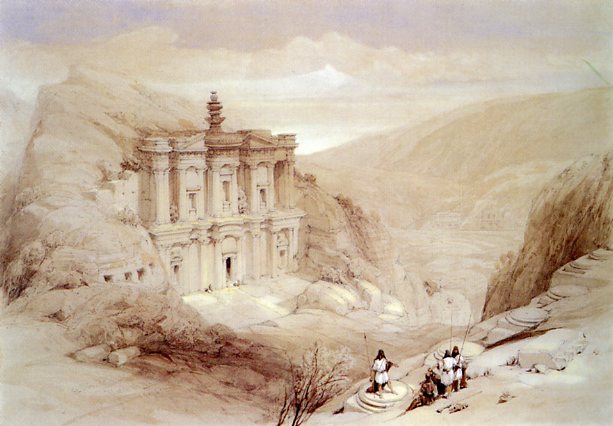
Petra was later annexed by the Roman Empire and continued to prosper until a major earthquake in 363 AD destroyed much of the city in the 4th century AD. The earthquake, coupled with changes in trade routes, led to the city's decline, and it was eventually abandoned.
Petra Historical Site, How My Love for This Wonder Was Born
Just as I wrote in the article about My visit to the Wadi Rum desert, that place had been etched in my retina after watching the epic film Lawrence of Arabia, Petra would also remember it when watching one of the great adventure classics, Indiana Jones and the Last Crusade.
As a kid, I really enjoyed watching these kinds of movies; they stimulated my imagination, taking me to remote places from the comfort of my couch. If you recall, at the end of the movie, they reached a lost city in search of the chalice from which Jesus drank at the Last Supper. That city was none other than Petra.
Since that film, Petra has gained massive worldwide notoriety and has become one of the most exotic places to visit and enjoy.
What it's like to visit Petra
It is a pleasure to visit Petra. Unlike when I visited the pyramids of Egypt On my account, where the Egyptians are constantly harassing you and trying to deceive you all the time, the opposite happens here.
As soon as you enter, you feel a different atmosphere. Jordanians are very different from Egyptians. Calm, friendly, and respectful, they don't invade your personal space. It contrasted sharply with the image I had at the entrance to the pyramids, where it was full of fake guides trying to convince us with a series of lies to hire their services.
At Petra, none of that happens. You can move around the entire complex freely, and no one will say a word to you. No tricks or scams, just enjoy this wonderful place. You can stop to rest or buy something in one of the shops within the complex, and no one will bother you. I remember how much I loved that feeling of peace :D.
What to see in Petra: A complete guide to exploring the lost city
1. The Siq
The adventure in Petra begins with the Siq, an impressive 1.2-kilometer-long canyon that winds between rock walls up to 80 meters high. This gorge is the main entrance to the archaeological site and offers an unforgettable journey to the main attraction: the Treasury.
It acts as a prelude to what you'll see later. You can feel the excitement and joy of everyone else present, who, like us, are entering (or leaving) this ancient world.
The only thing I found a little annoying about this part were the carriages with tourists pulled by mules, which go back and forth through the narrow canyon, causing us to have to move or stop frequently to let them pass.
Distance from the entrance: 1.2 km
2. The Treasury (Al-Khazneh)
It is the iconic image of Petra. Al-Khazneh, known as the Treasury, is a majestic, 40-meter-high rock-cut temple that served as a royal tomb. The façade is one of the most beautiful sights you'll see in the entire complex.
It is doubtful whether it was a temple or a royal tomb, since the looting carried out by Bedouins during the centuries prior to its discovery prevents us from knowing for certain its use.
¿What's inside? You might ask. Well, reality is quite different from what we saw in the Indiana movie. There's no long corridor filled with traps and precipices with the Holy Grail waiting for us to drink and obtain eternal life... no. In fact, there's a small, empty room, which we can only see from the outside, as entry is prohibited. But it's still a marvel to see and admire how they've excavated the mountain rock to give it that shape.
As a recommendation, if you want to visit it without people around, you should get up early and go first thing in the morning or, if necessary, at dusk before the complex closes, which is when the sunlight enhances the pink tones of the façade.
3. The Street of Facades
Following the path from the Treasury, you'll reach the Street of Facades, a group of rock-cut tombs. It's an excellent place to appreciate Nabataean architecture and understand Petra's importance as a commercial and religious center.
Distance from the Treasury: 300 meters
4. The Nabatean Theatre
Built in the 1st century AD, this rock-cut theater could hold up to 8,500 spectators. Unlike Roman theaters, Petra's was carved directly into the rock, making it one of the most unique structures at the site.
Distance from the street to the facades: 200 meters
5. The Royal Tombs
A little further on, on a hill, are the Royal Tombs, a series of impressive rock-cut mausoleums. Notable among them are the Urn Tomb, the Palace Tomb, and the Silk Tomb.
Distance from the Nabatean Theatre: 500 meters
6. The main street of the city
Passing the royal tombs, you reach the city's nerve center. This street was once the city's main artery, housing merchant stalls and providing access to various temples, churches, and tombs.
At the end of the street begins the path to reach the other great attraction of the complex
7. The Monastery (Ad-Deir)
To my surprise, one of the most impressive places in Petra, the Monastery. One always sees the image of the Treasury when searching the internet for Petra, but the reality is that the Monastery is larger and just as beautiful. The added bonus is that, being further away, there are fewer people around.
Architecturally it is an example of the classic Nabataean style. Built in the 1st century in honor of Obodas IIt measures 50 meters wide by 45 meters high.
To get here, you'll have to climb approximately 800 steps carved into the rock. The hike is worth it, as Ad-Deir, as I mentioned before, is even larger than the Treasury and offers panoramic views of the desert.
Distance from the Royal Tombs: 3 km (approx. 1 hour walk)
8. The Altar of Sacrifices
This mountaintop viewpoint was used for religious ceremonies. From here, you can enjoy one of the best views of Petra.
Distance from the Nabatean Theatre: 1.5 km (steep climb)
9. Little Petra (Siq al-Barid)
Located about 9 km from the main complex, Little Petra is a less crowded but equally fascinating site. It is believed to have served as a resting place for merchant caravans arriving at the main city.
Distance from Petra entrance: 9 km by car
10. Petra at night
With a separate ticket, you can enter the complex at night, but only as far as the Treasury. I didn't do it because I thought it was expensive for the experience itself. You walk through the dimly lit Siq canyon until you reach the Treasury, where people sit around candles on the floor and music plays. It looks nice in the photos, but the duration is short and the price is high.
11. Hiking in Petra
There are several options to do Hiking inside the archaeological site of Petra or in the surrounding area. The most famous and not-so-long one takes you to the upper viewing point in front of the Treasury. It begins by passing the royal tombs and then loops around toward the Treasury. Right where the viewing point is, there's a small shop selling drinks and snacks, and you can take beautiful photos from another angle of the Treasury.
In the official website All the hiking possibilities inside and outside the archaeological site are mentioned.
Paid excursions
Some of the excursions you can book online are:
- Private tour of the city of Petra
- Transfers in Wadi Musa
- Excursion to Petra
- Jordan in full (including Petra, Wadi Rum and the Dead Sea)
How many days do I need to visit Petra?
At least one full day to see the highlights. If you start early and finish by closing time, you can see all the important sites of the archaeological site, including the Monastery.
But I recommend staying for two or three days. In my case, it was two full days, plus the morning of the third day. This way, I was able to include the trails that lead to the upper viewing point of El Tesoro and also the path that leads to the Altar of Sacrifice. And above all, I was able to take enough time to take lots of photos at different times of the day. This is important because some places get sun in the afternoon, and others in the morning.
The entire complex is a marvel. I think it's worth taking the time to enjoy it calmly.
How much does it cost to enter Petra?
There are options depending on the number of days we want to enter the complex:
Petra entrance fees
- 1-day ticket: 50 Jordanian dinars JOD ($70 USD).
- 2-day consecutive entry: 55 JOD ($77 USD).
- 3-day consecutive entry: 60 JOD ($84 USD).
Prices can be validated on the official website. Visit PetraThese rates apply to international visitors. Children under 12 are admitted free.
Jordan Pass
If you plan to visit several attractions in Jordan, purchasing the Jordan Pass may be a good idea. This includes:
- Entry visa to the country: valued at 40 JOD ($56 USD).
- Entrance to more than 40 tourist sites, including Petra, Wadi Rum and more attractions (list of included attractions).
There are three options depending on the number of days you want to spend inside the historic site of Petra:
- Jordan Wanderer: 70 JOD ($98 USD), includes 1 day in Petra.
- Jordan Explorer: 75 JOD ($105 USD), includes 2 consecutive days in Petra.
- Jordan Expert: 80 JOD ($112 USD), includes 3 consecutive days in Petra.
The Jordan Pass is convenient if you plan to stay at least three nights in Jordan, as the visa and Petra entry fee separately add up to more than the cost of the pass. You can validate this information and updated prices at the Jordan Pass official website.
Please note: The Jordan Pass is valid for three months after purchase. However, it will automatically expire one month after your first scan at your first attraction.
From the official website you can buy the Jordan Pass and have it ready to present anywhere they ask for it.
Petra by Night
The night show Petra by Night Not included in standard tickets or the Jordan Pass. This special event has an additional cost and offers a unique experience of Petra illuminated by thousands of candles.
Note: The prices mentioned are subject to change. It is recommended to check the updated rates at official sites before planning your visit.
What are the hours to visit Petra?
Daylight Savings Time (March 2nd to October 1st)
- Visit to the complex and visitor center: 6:00 – 18:00
- Ticket purchase: 07:00 – 15:00
Winter Schedule (from October 2 to March 1)
- Visit to the complex and visitor center: 6:30 – 17:00
- Ticket purchase: 07:00 – 14:00
You can validate the schedules on the official website of Visit Petra.
Where to stay in Wadi Musa to visit Petra
The base city for visiting the historic site of Petra is called Wadi Musa. It's a relatively small city full of hotel options for all tastes; after all, we're looking at one of the 7 wonders of the modern world. We stayed three nights at the Hotel Rose City InnVery nice and not too expensive. There are cheaper hostels and more expensive options. You can find any number of options on Booking.com by searching. Accommodations in the city of Wadi Musa.
How to get to Petra (Wadi Musa)
By car (The most flexible option)
If you rent a car, you can easily reach Petra from various cities in Jordan:
- From Amman: 235 km (about 3 hours) via the Desert Highway (Highway 15).
- From Aqaba: 125 km (about 2 hours) along the Desert Highway.
- From the Dead Sea: 200 km (about 3.5 hours) via the Panoramic Route (King's Highway).
By bus (The economic option)
- Jett Bus: Daily service between Amman and Petra. Departs early in the morning and returns in the afternoon. Duration: 3.5 hours.
- Local buses: They leave from Amman bus station, but they may not be as comfortable or regular.
By taxi or private transfer (Quick and convenient option)
- From Amman, the cost is around 90-120 JOD (depending on the negotiation).
- From Aqaba, it costs between 50-70 JOD.
- It is an ideal option if you are traveling in a group or want comfort.
By plane + ground transportation
There is no airport in Petra, but you can fly to:
- Queen Alia International Airport (Amman) and then take a car or bus.
- King Hussein International Airport (Aqaba), which is closer.
On the official website of Visit Petra They all mention these alternatives to get there.
When to go to Petra
During the warmer months (May, June, July, August), it can get very hot. Walking the entire site and any of the trails can be a real challenge in the sweltering heat.
In the other months it can get cool and a bit cold, but I find that more practical than suffering the heat.
Practical tips for visiting Petra
- Best timeArrive early to avoid crowds and heat. Even before opening, there are already people waiting, but few compared to those who will arrive later.
- Recommended duration: Minimum 1 day, ideally 2 to 3 days to explore without rushing.
- Clothing and footwear: Wear comfortable clothing and appropriate footwear for long walks.
- Water and snacksBring plenty of water and some light snacks. Although there are several shops inside the complex where you can buy food and drinks, they're always more expensive than outside.
- Tickets: The costs are detailed above. But don't forget that with the Jordan Pass You can include the entrance to Petra and save money.
Reflections on my visit to Petra
For me, it was a dream come true. One I'd had since I was a child. Exploring Petra is a unique experience. For me, it's the best of the seven modern wonders, along with Machu Picchu.
We're talking about an ancient rock city hidden among mountains and canyons. The time it must have taken to excavate the tombs, temples, and homes within the rocks makes it a true wonder.
This, combined with how easy and relaxing it is to explore from end to end, makes you want to return for several days (which is why I recommend the 3-day ticket). This isn't a minor issue. I think it's crucial when it comes to building the memories we'll have of a particular place. A few weeks ago, when I visited another ancient wonder like the Pyramids of Giza, my experience was completely different, and the memories I'm left with aren't as fond as those I had here.
And that's all. I hope this detailed guide will help you better organize your tour and make the most of this archaeological wonder. Any comments are welcome.
See you next time
Support The Prism of Fer!
Your support helps me continue creating free content on the blog. Thank you so much!


